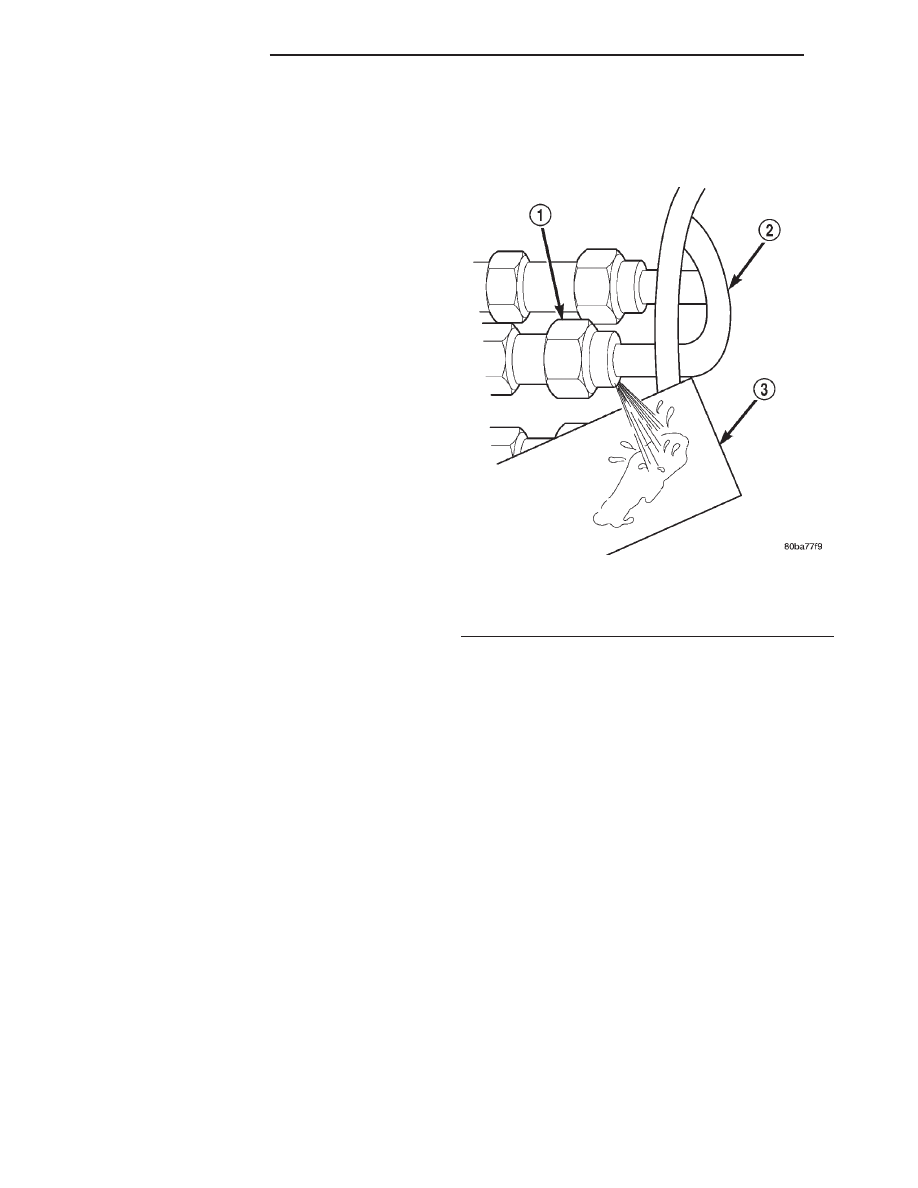Dodge Dakota (R1). Manual - part 576

types of clamps may cut into the hoses and cause
fuel leaks.
Where a rubber hose is joined to a metal tube
(staked), do not attempt to repair. Replace entire
line/tube assembly.
Use new original equipment type hose clamps.
Tighten hose clamps to 2 N·m (20 in. lbs.) torque.
HIGH-PRESSURE FUEL LINES
DESCRIPTION
CAUTION: The high–pressure fuel lines must be
held securely in place in their holders. The lines
cannot contact each other or other components. Do
not attempt to weld high–pressure fuel lines or to
repair lines that are damaged. Only use the recom-
mended lines when replacement of high–pressure
fuel line is necessary.
High–pressure fuel lines deliver fuel under pres-
sure of up to approximately 45,000 kPa (6526 PSI)
from the injection pump to the fuel injectors. The
lines expand and contract from the high–pressure
fuel pulses generated during the injection process. All
high–pressure fuel lines are of the same length and
inside diameter. Correct high–pressure fuel line
usage and installation is critical to smooth engine
operation.
WARNING:
USE
EXTREME
CAUTION
WHEN
INSPECTING FOR HIGH–PRESSURE FUEL LEAKS.
INSPECT FOR HIGH–PRESSURE FUEL LEAKS WITH
A SHEET OF CARDBOARD. HIGH FUEL INJECTION
PRESSURE CAN CAUSE PERSONAL INJURY IF
CONTACT IS MADE WITH THE SKIN.
DIAGNOSIS AND TESTING - HIGH-PRESSURE
FUEL LINE
High–pressure fuel line leaks can cause starting
problems and poor engine performance.
WARNING: DUE TO EXTREME FUEL PRESSURES OF
UP TO 45,000 KPA (6526 PSI), USE EXTREME CAU-
TION WHEN INSPECTING FOR HIGH–PRESSURE
FUEL LEAKS. DO NOT GET YOUR HAND, OR ANY
PART OF YOUR BODY NEAR A SUSPECTED LEAK.
INSPECT FOR HIGH–PRESSURE FUEL LEAKS WITH
A SHEET OF CARDBOARD. HIGH FUEL INJECTION
PRESSURE CAN CAUSE PERSONAL INJURY IF
CONTACT IS MADE WITH THE SKIN.
Start the engine. Move the cardboard over the
high–pressure fuel lines and check for fuel spray onto
the cardboard (Fig. 33). If a high–pressure line con-
nection is leaking, bleed the system and tighten the
connection. Refer to the Air Bleed Procedure in this
group for procedures. Replace damaged, restricted or
leaking high–pressure fuel lines with the correct
replacement line.
CAUTION: The high–pressure fuel lines must be
clamped securely in the holders. The lines cannot
contact each other or other components. Do not
attempt to weld high–pressure fuel lines or to repair
lines that are damaged. Only use the recommended
lines when replacement of high–pressure fuel line
is necessary.
FUEL SHUT DOWN SOLENOID
DESCRIPTION
The fuel shutdown solenoid is controlled and
operated by the ECM.
The fuel shutdown (shut-off) solenoid is used to
electrically shut off the diesel fuel supply to the high-
pressure
fuel
injection
pump.
The
solenoid
is
mounted to the rear of the injection pump.
The solenoid controls starting and stopping of the
engine regardless of the position of the accelerator
pedal. When the ignition (key) switch is OFF, the
solenoid is shut off and fuel flow is not allowed to the
fuel injection pump. When the key is placed in the
ON or START positions, fuel supply is allowed at the
injection pump.
Fig. 33 Typical Fuel Pressure Test at Injection Pump
1 - FITTING
2 - HIGH PRESSURE LINE
3 - CARDBOARD
14a - 18
FUEL DELIVERY
R1
FUEL HIGH PRESSURE LINES (Continued)